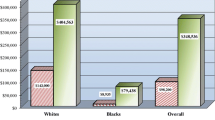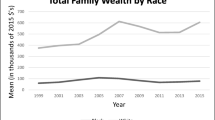Abstract
The emerging subfield of stratification economics is a response to the orthodoxy’s resistance to recognizing the role of racial and ethnic disparities and its penchant for adopting cultural explanations for intergroup differences. With this view, the literature on the racial wealth gap and its particular embrace of the Life Cycle Hypothesis (LCH) offers a clear example of this critique at work. Not only is the LCH incapable of explaining why the racial wealth gap is so much larger than the income gap, but its limitations restrict the range of explanations explored. As an alternative, this paper introduces the Wealth Privilege (WP) model. Unlike the LCH, the WP model can incorporate the effects of contemporary racism as well as the systemic sources that are a legacy of several centuries of racialized policies. Using evidence from the 2013 Survey of Consumer Finances (SCF), this article offers empirical corroboration as well. Since the SCF queries households on their attitudes toward saving and investment, this article investigates the extent that cultural differences explain the wealth gap. To limit the problem of skewness, which is inherent in wealth studies, the analysis uses an inverse hyperbolic-sine transformation of household net worth. The OLS regression results show scant support for key features of the LCH while demonstrating the importance of asset ownership and family support, both crucial facets of the WP model. Two different decomposition methods, Blinder - Oaxaca and DiNardo - Fortin - Lemieux, corroborate these conclusions. As wealth is easily transferable across generations, the evidence supports the contention that household wealth serves as a source of economic stratification as it functions to preserve and even widen the racial wealth gap.
Similar content being viewed by others
Notes
Unfortunately, she lumps these three covariates with a measure of inheritance.
The reader can find a fuller explanation of this model in Williams (2017).
In 2017, estates below $5.490 million escape estate taxation. Tax loopholes allow larger estates to avoid taxation as well.
The SCF does not measure future claims to Social Security.
Although this measure of normal income does not fully capture the permanent income concept, it likely represents the best driver of savings behavior..
As wealth is slightly more concentrated in the black and Latino communities, the wealth gap at the mean is smaller than that at the medians.
Among black households, the size of this number is partially, but not wholly, explained by their younger age.
Although the income coefficients are high, they are within the range found by Thompson and Suarez (2015).
The p-value on long run financial planning narrowly misses the standard for statistical significance among White households.
Among this group, measuring each asset category by its share of total assets may offer a more insightful method.
Evidence for this point is not provided in the paper.
References
Asante-Muhammed, D., Collins, C., Hoxie, J., & Nieves, E. The ever-growing gap: Without change, African-American and Latino families won’t match White wealth for centuries. 2016.
Altonji JG, Doraszelski U. The role of permanent income and demographics in black/white differences in wealth. J Hum Resour. 2005;40(1):1–30.
Avery R, Rendall M. “The contributions of inheritances to black-white wealth disparities in the United States”, Working Paper 97–08. Ithaca, N.Y: Bronfenbrenner Life Course Center; 1997.
Barsky R, Bound J, Charles KK, Lupton JP. Accounting for the black–white wealth gap: a nonparametric approach. J Am Stat Assoc. 2002;97(459):663–73.
Bates T. The changing nature of minority business: a comparative analysis of Asian, nonminority, and black-owned businesses. Rev Black Polit Econ. 1989;18(2):25–42.
Bertrand, M., & Mullainathan, S. Are Emily and Greg more employable than Lakisha and Jamal? A field experiment on labor market discrimination (No. w9873). National Bureau of Economic Research. 2003.
Blanchflower DG, Oswald A, Stutzer A. Latent entrepreneurship across nations. Eur Econ Rev. 2001;45(4):680–91.
Blau FD, Graham JW. Black-white differences in wealth and asset composition. Q J Econ. 1990;105(2):321–39.
Borjas, G. J., & Bronars, S. G. Consumer discrimination and self-employment (No. w2627). National Bureau of Economic Research. 1988.
Boshara R, Emmons WR, Noeth B. The demographics of wealth: how age, education and race separate thrivers from strugglers in today’s economy. Louis: Federal Reserve Bank of St; 2015.
Brown T. The intersection and accumulation of racial and gender inequality: Black women’s wealth trajectories. Rev Black Polit Econ. 2012;39(2):239–58.
Bucks BK, Kennickell AB, Moore KB. Recent changes in US family finances: Evidence from the 2001 and 2004 Survey of Consumer Finances. Fed Res Bull. 2006;A1:92.
Cagetti M, De Nardi M. Entrepreneurship, frictions, and wealth. J Polit Econ. 2006;114(5):835–70.
Carroll C. Why do the rich save so much? In: Slemrod JB, editor. Does Atlas Shrug? Cambridge: The Economic Consequences of Taxing the Rich. Harvard University Press; 2000.
Castaneda A, Díaz-Giménez J, Ríos-Rull JV. Accounting for the US earnings and wealth inequality. J Polit Econ. 2003;111(4):818–57.
Charles KK, Hurst E. The transition to home ownership and the black-white wealth gap. Rev Econ Stat. 2002;84(2):281–97.
Chiteji NS. The racial wealth gap and the borrower’s dilemma. J Black Stud. 2010;41(2):351–66.
Chiteji NS, Hamilton D. Family connections and the black-white wealth gap among middle-class families. Rev Black Polit Econ. 2002;30(1):9–28.
Chiteji NS, Stafford FP. Asset ownership across generations. Ann Arbor. 2000;1001:48106.
Coate D, Vanderhoff J. Race of the homeowner and appreciation of single-family homes in the United States. J Real Estate Fin Econ. 1993;7(3):205–12.
Collins, M., & Dylla, D. Mind the gap: Issues in overcoming the information, income, wealth, and supply gaps facing potential buyers of affordable homes. Neighborhood Reinvestment Corporation and LISC Center for Homeownership. 2001.
Conley, D. (1999). Being black, living in the red: Race, wealth, and social policy in America. Univ of California Press.
Darity WA, Hamilton D, Stewart JB. A tour de force in understanding intergroup inequality: an introduction to stratification economics. Rev Black Polit Econ. 2015;42(1–2):1–6.
Darity WA, Mason PL, Stewart JB. The economics of identity: the origin and persistence of racial identity norms. J Econ Behav Organ. 2006;60(3):283–305.
Darity WA, Nicholson MJ. Racial wealth inequality and the Black family. African American family life: Ecological and cultural diversity. New York: Guilford Press; 2005. p. 78–85.
De Nardi M. Wealth inequality and intergenerational links. Rev Econ Stud. 2004;71(3):743–68.
De Nardi, M. Quantitative models of wealth inequality: a survey (No. w21106). National Bureau of Economic Research. 2015.
DiNardo J, Fortin N, Lemieux T. Labor Market Institutions and the Distribution of Wages. Econometrica. 1996;64:1001–44.
Dynan KE, Skinner J, Zeldes SP. Do the rich save more? J Polit Econ. 2004;112(2):397–444.
Emmons WR, Ricketts LR. College Is Not Enough: Higher Education Does Not Eliminate Racial and Ethnic Wealth Gaps. Federal Reserve Bank of St. Louis. Review. 2017;99(1):7–39.
Fairlie RW. The absence of the African-American owned business: An analysis of the dynamics of self-employment. J Labor Econ. 1999;17(1):80–108.
Fairlie RW, Meyer BD. Trends in self-employment among white and black men during the twentieth century. J Hum Resour. 2000:643–69.
Firpo, S., Fortin, N., & Lemieux, T. (2007). Decomposing wage distributions using recentered influence function regressions. University of British Columbia (June).
Flippen C. Unequal returns to housing investments? A study of real housing appreciation among black, white, and Hispanic households. Soc Forces. 2004;82(4):1523–51.
Francis JL. Wealth and the capitalist spirit. J Macroecon. 2009;31(3):394–408.
Franklin, R. S. Shadows of race and class. University of Minnesota Press. 1991.
Gittleman M, Wolff EN. Racial differences in patterns of wealth accumulation. J Hum Resour. 2004;39(1):193–227.
Heer B. Wealth Distribution and Optimal Inheritance Taxation in Life-cycle Economies with Intergenerational Transfers. Scand J Econ. 2001;103(3):445–65.
Hendricks, L. (2002). Accounting for patterns of wealth inequality.
Huggett M. Wealth distribution in life-cycle economies. J Monet Econ. 1996;38(3):469–94.
Hurst, E., Luoh, M. C., Stafford, F. P., & Gale, W. G. (1998). The wealth dynamics of American families, 1984-94. Brookings papers on Economic activity, 267-337.
Iceland, J., & Weinberg, D. H. (2002). Racial and ethnic residential segregation in the United States 1980–2000. Bureau of Census.
Joint Committee on Taxation (JCT). Estimates of federal tax expenditures for fiscal years 2012–2017. JCS-1-13. Washington, DC: Government Printing Office; 2013.
Juster FT, Smith JP, Stafford F. The measurement and structure of household wealth. Labour Econ. 1999;6(2):253–75.
Keister LA, Moller S. Wealth inequality in the United States. Annu Rev Sociol. 2000;26(1):63–81.
Krivo LJ, Kaufman RL. Housing and wealth inequality: Racial-ethnic differences in home equity in the United States. Demography. 2004a;41(3):585–605.
Kochhar, R., & Fry, R. Wealth inequality has widened along racial, ethnic lines since end of Great Recession. Pew Research Center, 12. 2014.
Krivo LJ, Kaufman RL. Housing and wealth inequality: Racial-ethnic differences in home equity in the United States. Demography. 2004b;41(3):585–605.
Krusell P, Smith AA Jr. Income and wealth heterogeneity in the macroeconomy. J Polit Econ. 1998;106(5):867–96.
Laitner, J. Secular changes in wealth inequality and inheritance. Econ J. 2001, 691-721.
Long JE, Caudill SB. Racial differences in homeownership and housing wealth, 1970–1986. Econ Inq. 1992;30(1):83–100.
Lui M, Robles B, Leondar-Wright B, Brewer R, Adamson R. The color of wealth: the story behind the US racial divide. New York: The New Press; 2006.
Maroto M. Growing farther apart: racial and ethnic inequality in household wealth across the distribution. Soc Sci. 2016;3:801–24.
McKernan, S. M., Ratcliffe, C., Steurle, E., & Zhang, S. Impact of the Great Recession and Beyond. 2014.
Menchik PL, Jianakoplos NA. Black-White Wealth Inequality: Is Inheritance the Reason? Econ Inq. 1997;35(2):428–42.
Modigliani, F., & Brumberg, R. Utility analysis and the consumption function: An interpretation of cross-section data. Franco Modigliani. 1954, 1.
Mullainathan S, Shafir E. Savings policy and decision-making in low-income households. Insuff Funds: Savings, Assets, Credit, Banking Among Low-Income Households. 2009;121:129–33.
Munnell, A. H., Tootell, G. M., Browne, L. E., & McEneaney, J. Mortgage lending in Boston: Interpreting HMDA data. Am Econ Rev. 1996, 25-53.
Oliver, M. L., & Shapiro, T. M. Black wealth, white wealth: A new perspective on racial inequality. Taylor & Francis. 2006.
Pager D. The Mark of a Criminal Record. Am J Sociol. 2003;108(5):937–75.
Scholz, J. K., & Levine, K. US black-white wealth inequality. In K. Neckerman, Social inequality (pp. 895-929), Russell Sage Foundation. 2004.
Shapiro, T. M. The hidden cost of being African American: How wealth perpetuates inequality. Oxford University Press. 2004.
Shin, E. H. Black-White Differences in Wealth Accumulation Among Americans Nearing Retirement. 2010.
Smith, J. P. Racial and ethnic differences in wealth in the Health and Retirement Study. J Hum Resour. 1995, S158-S183.
Smith JP. Healthy Bodies and Thick Wallets: The Dual Relation between Health and Economic Status. J Econ Perspect. 1999;13(2):145–66.
Smith JP. Why is wealth inequality rising? Causes Consequen Increas Inequal. 2001;2:83–116.
Tippett, R., Jones-DeWeever, A., Rockeymoore, M., Hamilton, D., & Darity, W. Beyond Broke: Why Closing the Racial Wealth Gap is a Priority for National Economic Security. Report prepared by Center for Global Policy Solutions and The Research Network on Ethnic and Racial Inequality at Duke University with funds provided by the Ford Foundation. 2014.
Turner, M. A. Discrimination in metropolitan housing markets: National results from phase I of HDS2000. 2002.
Thompson JP, Suarez G. Exploring the racial wealth gap using the survey of consumer finances. Finance and Economics Discussion Series 2015–076. Washington: Board of Governors of the Federal Reserve System; 2015.
Williams RB. The privileges of wealth: rising inequality and a widening racial gap. New York: Routledge; 2017.
Wolff EN. The Accumulation of Household Wealth over the Life-Cycle: A Microdata Analysis*. Rev Income Wealth. 1981;27(1):75–96.
Wolfson, M. The causes of inequality in the distribution of wealth: A simulation analysis. Ph.D. Thesis, Cambridge University. 1977.
Author information
Authors and Affiliations
Corresponding author
About this article
Cite this article
Williams, R.B. Wealth Privilege and the Racial Wealth Gap: A Case Study in Economic Stratification. Rev Black Polit Econ 44, 303–325 (2017). https://doi.org/10.1007/s12114-017-9259-8
Published:
Issue Date:
DOI: https://doi.org/10.1007/s12114-017-9259-8




